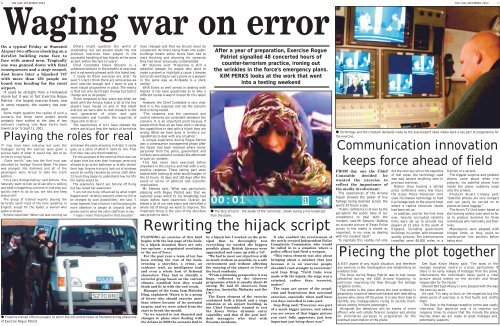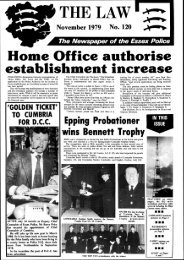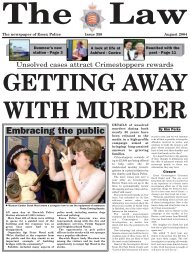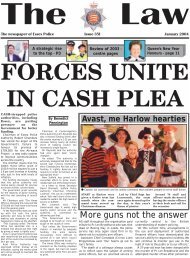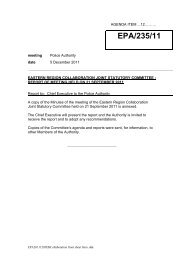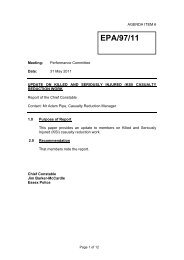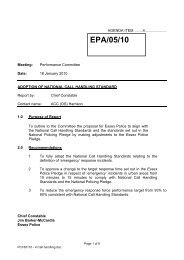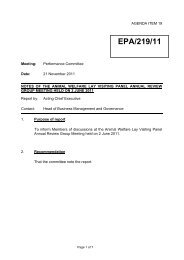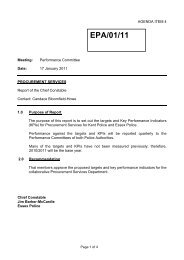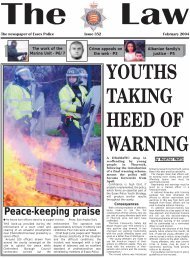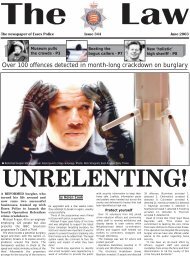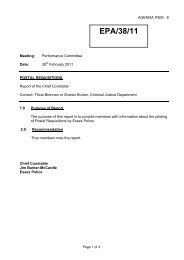DEC LAW P1 - Essex Police
DEC LAW P1 - Essex Police
DEC LAW P1 - Essex Police
Create successful ePaper yourself
Turn your PDF publications into a flip-book with our unique Google optimized e-Paper software.
6 THE <strong>LAW</strong>, <strong>DEC</strong>EMBER 2003 THE <strong>LAW</strong>, <strong>DEC</strong>EMBER 2003 7<br />
Waging war on error<br />
On a typical Friday at Stansted<br />
Airport two officers checking on a<br />
derelict building came face to<br />
face with armed men. Tragically<br />
one was gunned down with fatal<br />
consequences and a siege ensued.<br />
Just hours later a hijacked 747<br />
with more than 150 people on<br />
board was heading for the rural<br />
airport.<br />
It could be straight from a Hollywood<br />
movie but it was in fact Exercise Rogue<br />
Patriot - the largest exercise <strong>Essex</strong>, and<br />
in some respects, the country has ever<br />
seen.<br />
Some might question the reality of such a<br />
scenario but those same people would<br />
probably have scoffed at the idea of two<br />
airliners crashing into New York’s twin<br />
towers prior to Sept 11, 2001.<br />
Others might question the worth of<br />
‘pretending’ but can anyone doubt the role<br />
previous exercises have played in the<br />
successful handling of two hijacks at the same<br />
airport within the last 10 years?<br />
Chief Constable David Stevens is a<br />
vehement believer in the benefits of exercises<br />
and is extremely pleased with this latest test.<br />
“I really do think exercises are vital,” he<br />
said. “In fact I think there are some areas we<br />
don’t exercise enough and I want to put a<br />
more robust programme in place. The reality<br />
is that not only do threats change but tactics<br />
change and so do people.<br />
“Even compared to four years ago when we<br />
dealt with the Ariana hijack a lot of the key<br />
players have moved on and in this latest<br />
exercise we were able to look forward to the<br />
next generation of silver and gold<br />
commanders and transfer the expertise of<br />
those still in force.”<br />
The experiences of 9-11 have showed the<br />
entire world just how the tactics of terrorists<br />
Playing the roles for real<br />
IT may have been role-play but even the<br />
‘hostages’ during the exercise were given a<br />
surreal taste of what it would feel like to be<br />
victim to a real hijack.<br />
“Quite horrific” was how the first hour was<br />
described by ‘hostage’ Simone Wade. The plane<br />
was plunged into darkness and all of the<br />
passengers were forced to take the crash<br />
position.<br />
“It’s a very strange feeling,” said Simone. “You<br />
naturally want to look up to see who is talking<br />
and what is happening, but even in role-play you<br />
quickly learn to do as you are told and keep<br />
statue still.”<br />
The group of trained experts playing the<br />
terrorists spent most of the time speaking in<br />
English, except for the leader, a woman who<br />
spoke in Arabic.<br />
Simone explained: “When she was running up<br />
and down the plane shouting in Arabic it really<br />
gave us a sense of what it could be like. That<br />
first hour was very disorientating.”<br />
For the purposes of the exercise there was lots<br />
of down time but even then ‘hostages’ were only<br />
allowed to go to the bathroom or briefly stretch<br />
their legs. Anyone trying to look out of windows<br />
would be swiftly rebuked by airline staff. After<br />
23 hours they began to understand how horrific<br />
the reality would be.<br />
The experience hasn’t put Simone off flying<br />
but has raised her awareness.<br />
“I am not one to be influenced by what might<br />
happen and I certainly wouldn’t allow my life to<br />
be changed by such possibilities,” she said. “I<br />
know, however, that in future I will be paying far<br />
more attention to people at airports and on<br />
planes and to what the cabin staff have to say.<br />
“I hope I never find myself in that situation.”<br />
● Firearms trained officers prepare to storm the old control tower at Stansted during phase one<br />
of Exercise Rogue Patriot.<br />
have changed and that we should never be<br />
complacent. Airliners being flown into public<br />
buildings means police forces have had to<br />
start thinking and planning for scenarios<br />
they had never previously contemplated.<br />
Mr Stevens said: “Hijacking is still a<br />
potential weapon for people who want to<br />
make a protest or highlight a cause. Likewise<br />
terrorists wanting to use a plane as a weapon<br />
in the same way as Al-Qaeda is a stark<br />
reality.”<br />
With <strong>Essex</strong> so well versed in dealing with<br />
hijacks it has been questioned as to why a<br />
different scenario wasn’t chosen for this latest<br />
test.<br />
However, the Chief Constable is very clear<br />
that it is the response and not the scenario<br />
that is being tested.<br />
“The response and the command and<br />
control elements are consistent whatever the<br />
scenario. It is an important point because if<br />
people think that all we have done is develop<br />
the capabilities to deal with a hijack they are<br />
wrong. What we have done is reinforce our<br />
capabilities to deal with any situation.”<br />
A unique experience during Rogue Patriot<br />
was a consequence management phase after<br />
the hijack had been resolved where senior<br />
personnel from the police, government and<br />
military were asked to consider the aftermath<br />
of such an incident.<br />
This had never been exercised before<br />
anywhere in the country and met with a very<br />
positive response. Those taking part were<br />
tasked with looking at what would happen in<br />
the 10 hours, 10 days and 100 days after the<br />
event in terms of political and economic<br />
implications.<br />
Mr Stevens said: “What was particularly<br />
pleasing with Rogue Patriot was that we<br />
explored areas which to my knowledge had<br />
never before been examined. Overall we<br />
tested a lot of our new plans and identified a<br />
whole list of things we want to improve. The<br />
important thing is the core of the structure<br />
was proven to work.”<br />
After a year of preparation, Exercise Rogue<br />
Patriot signalled 48 concerted hours of<br />
counter-terrorism practice, ironing out<br />
the wrinkles in the force’s emergency plans.<br />
KIM PERKS looks at the work that went<br />
into a testing weekend<br />
● The face of terror - the leader of the ‘terrorists’, shown during a live broadcast<br />
from the plane.<br />
Rewriting the hijack script<br />
PLANNING an exercise of this kind<br />
begins with the last page of the book.<br />
In a hijack situation there are only<br />
two options - a negotiated resolution<br />
or the use of force.<br />
For the past year a team of ten has<br />
been writing the rest of the book,<br />
creating a storyline, a crime, an<br />
evidence trail, an intelligence trail<br />
and even a whole host of fictional<br />
characters. They had to identify a<br />
terrorist group based on the current<br />
climate, establish how they would<br />
think and fit in with the end result.<br />
Manager of the team, Insp Malcolm<br />
Ding, explained: “<strong>Essex</strong> is in a group<br />
of forces who should exercise more<br />
than others because of its potential<br />
targets, and we were asked from the<br />
start to break the mould.<br />
“As we wanted to test Stansted and<br />
changes to plans since dealing with<br />
the Ariana in 2000 the scenario had to<br />
be a hijack but I worked on the principal<br />
that to thoroughly test<br />
everything we needed the biggest<br />
possible plane. British Airways were<br />
approached and came up with a 747.<br />
“We had to meet our objectives with<br />
as much realism as possible, in a safe<br />
environment and without affecting<br />
the running of the airport or lives of<br />
the local residents.<br />
“From a planning perspective it was<br />
huge, reflected by the observer<br />
programme which is usually about 40<br />
strong. We had 85 observers from<br />
America, Australia, Malaysia and the<br />
UN.”<br />
The <strong>Essex</strong> element of the exercise<br />
contained both a hijack and a siege<br />
situation at an airport building, as<br />
the Chief Constable wanted to test<br />
the <strong>Essex</strong> <strong>Police</strong> dynamic entry<br />
capability and that of the post incident<br />
managers who deal with<br />
firearms incidents.<br />
It also enabled the involvement of<br />
the newly created Independent <strong>Police</strong><br />
Complaints Commission who would<br />
be called in to a situation where a<br />
police officer had fired a weapon.<br />
“This extra element was also about<br />
bringing about a mindset that just<br />
because it is an exercise people<br />
shouldn’t rush straight to terrorism,”<br />
said Insp Ding. “Until links were<br />
made with the hijack, the seige was a<br />
criminal, rather than terrorist,<br />
matter.”<br />
The team are aware of the scepticism<br />
and frustrations that surround<br />
exercises, especially when staff have<br />
rest days cancelled to take part.<br />
Insp Ding said: “Everyone was part<br />
of a much bigger picture, and unless<br />
you are aware of that bigger picture<br />
you can’t fully appreciate just how<br />
important just being there was.”<br />
● Technology and the constant demands made by the ever-present news media were a key part of preparations for<br />
the exercise.<br />
Communication innovation<br />
keeps force ahead of field<br />
FROM day one the Chief<br />
Constable decided he<br />
wanted the exercise to<br />
reflect the importance of<br />
the media involvement.<br />
The experiences of the Ariana<br />
hijack showed the power of live<br />
footage being beamed across the<br />
world 24 hours a day.<br />
“Public confidence is driven by the<br />
perception the public have of our<br />
competence to deal with the<br />
incident,” said Mr Stevens. “Getting<br />
an accurate picture of <strong>Essex</strong> <strong>Police</strong><br />
across in the media is almost as<br />
important, in my view, as dealing<br />
with the incident itself.”<br />
To replicate this reality, not only<br />
A KEY aspect of any hijack situation, and therefore<br />
any exercise, is the investigation and establishing an<br />
evidence trail.<br />
The focus during Rogue Patriot was to test issues<br />
identified during the 2000 Ariana hijacking, in<br />
particular improving the flow through the hostage<br />
reception centre.<br />
The centre is the place where the best evidence is<br />
gleaned by a team of detectives tasked with debriefing<br />
anyone who comes off the plane. It is also their task to<br />
identify any hostage-takers trying to secrete themselves<br />
among innocent passengers.<br />
Alongside the detectives will be scenes of crime<br />
officers who will collate forensic samples and photos<br />
for elimination purposes in preparation for the<br />
eventual examination of the plane.<br />
did the exercise call on the expertise<br />
of real press, the technology used<br />
was way beyond anything seen in<br />
previous exercises.<br />
Rather than holding a stilted<br />
press conference every few hours<br />
the <strong>Essex</strong> <strong>Police</strong> Television Unit<br />
used microwave technology to feed<br />
live footage back to the airport hotel<br />
where a replica television studio<br />
had been set up.<br />
In addition, and for the first time<br />
ever, heavily encrypted satellite<br />
links were set up to provide key<br />
players at 13 sites in the south of<br />
England, including government<br />
buildings in London, with broadcast<br />
quality pictures. The transmissions<br />
travelled some 88,000 miles in a<br />
fraction of a second.<br />
The biggest surprise and greatest<br />
drama came about when live<br />
pictures, via satellite phone from<br />
inside the plane, suddenly leapt<br />
onto the screens.<br />
Producer Stuart Creasey said:<br />
“Satellite phones are very compact<br />
and can easily be carried on to<br />
planes as hand luggage.”<br />
The force’s TV Unit team, based at<br />
the training centre, even went so far<br />
as to produce dummies for those<br />
individuals who notionally lost their<br />
lives.<br />
Mannequins were adapted with<br />
hinged limbs so they could be<br />
manoeuvred into position before<br />
being shot.<br />
Piecing the plot together<br />
Det Supt Kevin Macey said: “The work in the<br />
hostage reception centre is crucial, particularly if<br />
there is an early release of hostages from the plane.<br />
Interviewing the individuals helps paint a vital<br />
picture about events on the aircraft and those<br />
responsible for the hijack.”<br />
Overall Det Supt Macey is very pleased with the way<br />
the exercise went.<br />
He said: “It’s easy to focus on the negatives but the<br />
whole point of exercises is to find faults and rectify<br />
them.<br />
“The flow in the hostage reception centre was vastly<br />
improved. Our objective now is to improve our<br />
response times to ensure that the minute the plane<br />
touches down we are ready to greet hostages and,<br />
potentially, suspects.”


